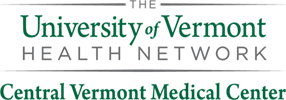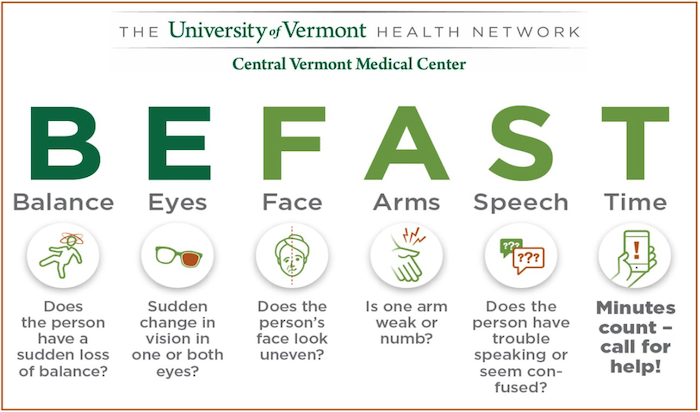The Stroke Program at Central Vermont Medical Center is a multidisciplinary stroke center. We offer comprehensive care, from prevention to rehabilitation, with treatment options and therapies focused around the individual needs of our patients.
Stroke is the leading cause of disability and the fifth-most prevalent cause of death in the United States. However, despite these alarming statistics, it is believed that 80% of strokes can be prevented.
What Is a Stroke?
A stroke occurs when a blood vessel that carries oxygen and nutrients to the brain is blocked (ischemic stroke) or bursts (hemorrhagic stroke). When this happens, the brain can’t get the blood or oxygen it needs, causing brain cells to die. This can happen rapidly, which is why stroke is a time-dependent emergency that must be treated immediately.
The Central Vermont Medical Center Stroke Program
The Stroke Program at Central Vermont Medical Center is a multidisciplinary stroke center. Our team works within the UVM Health Network and as part of a regional referral center that provides excellence in patient care and leadership in stroke education.
We offer comprehensive care, from prevention to rehabilitation, with treatment options and therapies focused around the individual needs of our patients. Our knowledgeable physicians are highly trained in diagnosing and treating stroke, using advanced technology and rigorous medical standards. Each year, the UVM Health Network treats over 600 patients.
Our Team
Our team approach brings together a range of physicians and clinicians to provide optimal stroke care. Central Vermont Medical Center's multidisciplinary Acute Care Stroke team includes the following :
- Care managers
- Chaplains
- Dieticians
- Hospitalists
- Licensed Nursing Assistants
- Neurologists
- Nurses
- Pharmacists
- Physical therapists, occupational therapists and speech-language pathologists
- Radiologists
- Stroke program coordinator
- Palliative care specialists
When a patient presents with stroke symptoms, the acute care stroke team works quickly to determine if the patient is eligible for time-sensitive interventions requiring transfer to an alternative stroke center. Patients admitted to Center Vermont Medical Center for stokes receive a full workup to determine the cause of the stroke, which may include brain or blood vessel imaging, lab work, cardiac rhythmic monitoring and / or ultrasound of the heart.
Stroke Treatments and Services
The Stroke Team assesses and treats a variety of cerebrovascular conditions, with the most common being ischemic stroke, hemorrhagic stroke, and transient ischemic attack (TIA). The Stroke team will coordinate a timely transfer to an alternative stroke center for some treatment interventions. Providers may use a combination of medical therapy and surgical treatment to treat your condition, including:
- Providing rapid diagnosis and treatment
- Administering clot-busting medication to prevent the progression of symptoms
- Identifying whether you could benefit from interventional therapies
Stroke Rehabilitation
After treatment, you may require rehabilitation to recover from your stroke. Stroke rehabilitation begins during hospital admission, with assessments by our knowledgeable and experienced physical therapists, occupational therapists and speech-language pathologists, who will then provide recommendations and develop individualized treatment to ensure the safest option and best outcomes for our stroke patients.
Our skilled Care Management team will partner with you, your support persons and your care team to develop a person-centered discharge plan that will optimize your recovery to help you regain as much function and independence as possible.
Stroke Prevention
Click to see full BEFAST infographic pdf
To Reduce Your Risk of Stroke
- Know your blood pressure and work with your healthcare provider if it is elevated.
- Find out whether or not you have atrial fibrillation.
- If you smoke, stop.
- Find out if you have high cholesterol.
- If diabetic, follow recommendations to control your diabetes.
- Include exercise in your daily routine and maintain a healthy weight.
- Enjoy a lower-sodium, lower-fat diet.
Secondary Stroke Prevention
Patients who have suffered a stroke are at higher risk of having another. Work with your healthcare provider to make a secondary stroke prevention plan which may include:
- Healthy diet
- Taking prescribed medications as ordered
- Losing weight and/or maintain a healthy weight
- Following your prescribed diabetes regimen
- Managing high blood pressure
- Controlling your cholesterol
- Quitting smoking, tobacco, and/or vaping
- Cardiac monitoring
Resources
There is an abundance of stroke information and resources that can be accessed online. At the UVM Medical Center, we adhere to the American Stroke Association guidelines for stroke care.
The UVM Health Network facilitates a Stroke Support group; please call for additional details.
- Stroke Support Group - Becky Louko, RPT, (802) 847-0142
We also recommend the following websites for additional information:
- Brain Aneurysm Foundation
- Centers for Disease Control and Prevention
- Children's Hemiplegia and Stroke Association
- Child Neurology Foundation
- International Alliance for Pediatric Stroke
- National Aphasia Association
- National Institute of Neurological Disorders and Stroke
- Young Stroke
Other Resources
Below is a list of additional resources to help you learn more about stroke prevention, treatment and rehabilitation.
- About Stroke - Hemorrhagic
- About Stroke - Ischemic and TIA
- Caregiver Support
- Life After Stroke
- Pediatric Stroke
- Stroke Prevention
- Young Adult Stroke
Connect with the Stroke Program
Scott Bagg, RN, CVMC Stroke Coordinator: 802-371-5964


